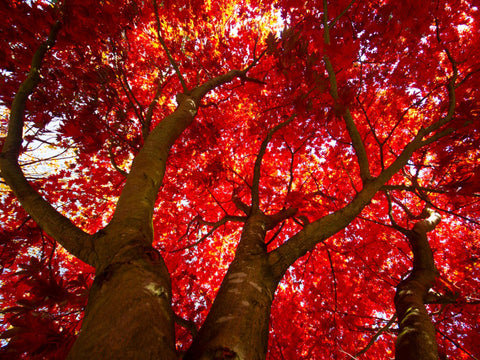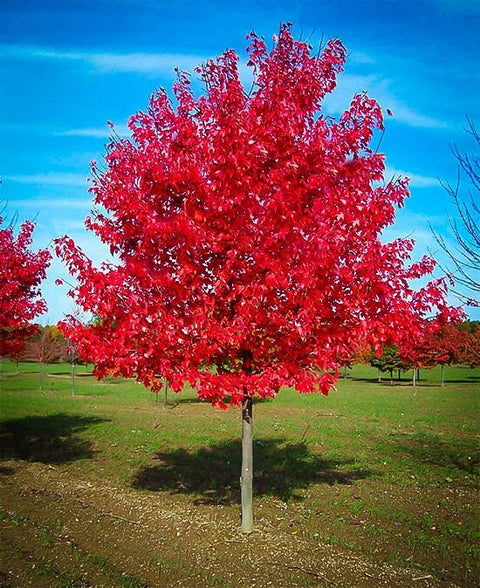

Red Maple is a stunning fall foliage, fast growing tree.
The stunning red maple tree, known botanically as the Acer rubrum, is very popular in most eastern and central parts of the United States. This classic deciduous cultivar has a lovely oval-shaped canopy with robust red foliage. The canopy rises tall and offers a good deal of shade. This attractive tree grows quickly and can reach heights of up to 75 feet, with the average height being around 45 feet. Red maple thrives well in most USDA hardiness zones 9, where moisture and sunshine are adequate.
Landscape Environments and Uses
You will find the red maple in rural, suburban, and even urban environments. Many arborists recommend this showy tree due to its fast growth and well-organized root system that doesn’t spread randomly or aggressively. The branches are sturdy and not inclined to become brittle and break. This tree is fairly tidy, making it ideal for places like residential lawns, urban parks, and golf courses. The shade of this maple is excellent for warmer climates where sunshine is abundant.
Its ornamental quality with those lovely red leaves sets the red maple apart from other maple trees. The leaves can change from red to orange or yellow in late fall. The color variation will depend on local climate and moisture conditions. In the northeast, the leaves will drop when the first frost appears.
In spring, the tree gives birth to red flowering buds and fruits along with emerging new leaves. This takes place around January in the deep south and May in the north. The seeds of the flowers will surely attract wildlife as a food source, such as birds and squirrels, helping to support the natural ecosystem.
Planting and Maintaining Red Maples
It is best to source a red maple from a local vendor with bare-root trees already acclimated to the regional climate and soil conditions. This tree prefers damp locations and soil to drier and more alkaline ones. A knowledgeable arborist understands how to properly transplant a young red maple in well-drained sandy, clay, or loam soil and may advise against planting this varietal in areas where drought conditions are common or where the soil is high in saline. Areas with partial shade to full sunlight are best.
Once planted, irrigation is often recommended to support the root system and encourage growth. This is especially true in urban environments where hardscapes might be nearby that cause water to run off into a street drainage system and away from tree roots. Trees can be selectively pruned to deter branches that are so large in diameter that they are more than half the size of the trunk, which can threaten the structural integrity of the tree.
The bark of the tree trunk is thin compared to some other species. Therefore, it is recommended that mowers and weed trimmers be used with special care so as not to damage the bark.
Lifespan of the Red Maple
The lifespan of a red maple tree varies depending on environmental conditions, including weather, soil conditions, and care. A red maple tree can live for over 100 years with optimal conditions and some TLC. Some have been known to live for up to 200 years. This hardy plant species will grow and flourish in various habitats, including suburban landscapes, urban greenspaces, wetlands areas, and upland forests.
Regular maintenance can influence the lifespan of a red maple. This includes careful branch pruning, adding nutrition to the soil, and providing adequate irrigation. A skilled arborist can also recommend planting the trees in suitable locations with optimal growing conditions to extend their lifespan.
In essence, you can expect to enjoy the beauty and shade of the majestic red maple for your entire life, as it is likely to thrive 100 years or longer.
30 days
Ships:
Bare root
Zone:
3-10
Exposure:
Full Sun
Deer Resistant:
Yes
Native:
Yes



